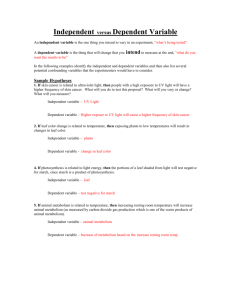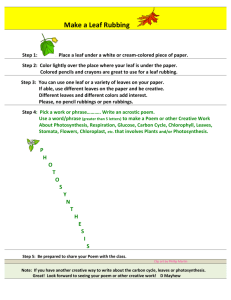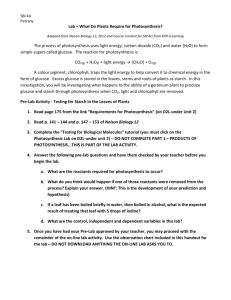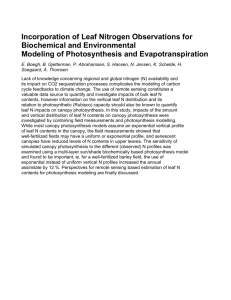PHOTOSYNTHESIS - Mindset Learn
advertisement
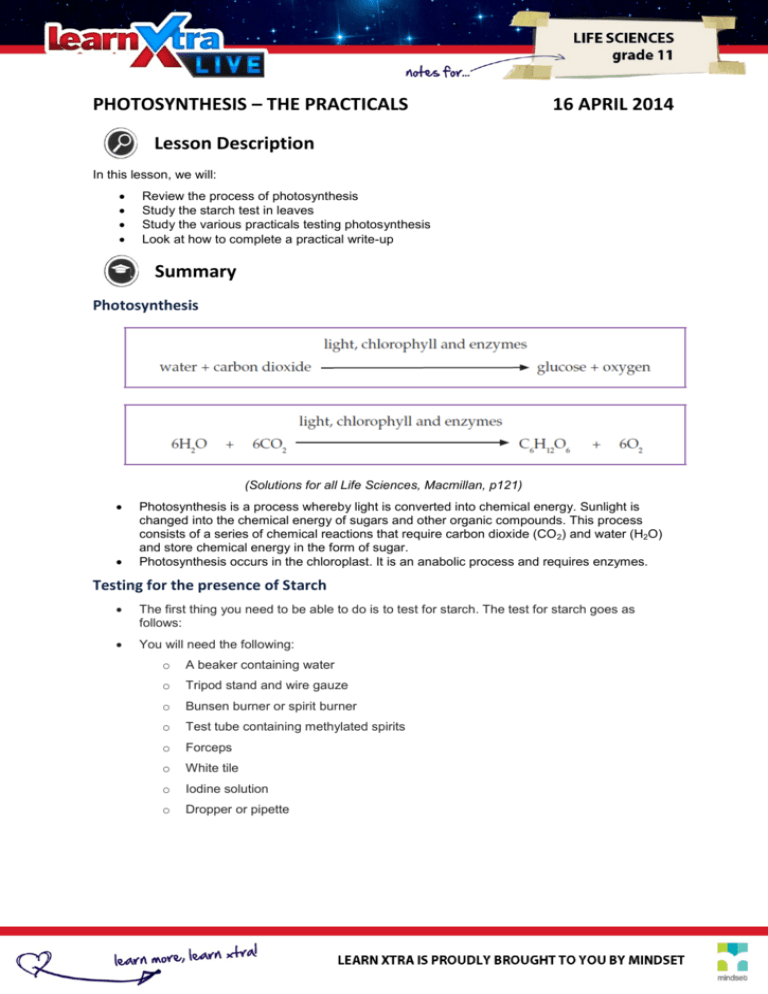
PHOTOSYNTHESIS – THE PRACTICALS 16 APRIL 2014 Lesson Description In this lesson, we will: Review the process of photosynthesis Study the starch test in leaves Study the various practicals testing photosynthesis Look at how to complete a practical write-up Summary Photosynthesis (Solutions for all Life Sciences, Macmillan, p121) Photosynthesis is a process whereby light is converted into chemical energy. Sunlight is changed into the chemical energy of sugars and other organic compounds. This process consists of a series of chemical reactions that require carbon dioxide (CO 2) and water (H2O) and store chemical energy in the form of sugar. Photosynthesis occurs in the chloroplast. It is an anabolic process and requires enzymes. Testing for the presence of Starch The first thing you need to be able to do is to test for starch. The test for starch goes as follows: You will need the following: o A beaker containing water o Tripod stand and wire gauze o Bunsen burner or spirit burner o Test tube containing methylated spirits o Forceps o White tile o Iodine solution o Dropper or pipette (Solutions for all Life Sciences, Macmillan, p128) Method Remove a leaf from a healthy growing plant. Put the leaf in boiling water When the leaf has gone soft (flaccid) take it out of the water and put it into methylated spirits or ethanol. (Keep the spirits away from flame.) The chlorophyll will move out of the leaf and into the methylated spirits or ethanol. Remove the leaf from the methylated spirits and wash it in the boiling water. Put the leaf onto the white tile and flatten it out. Drop a few drops of iodine solution onto the leaf and watch for a colour change. (http://hazell11bio.blogspot.com/2013/03/photosynthesis.html) Photosynthesis Practicals Practical 1 To determine whether light is necessary for photosynthesis Requirements: Pot plant that has been kept in the dark for 48 hours Tin foil Scissors Starch test materials Method: Cut a shape into a wide strip of tinfoil. Wrap the tin foil around the leaf with the shape on the top of the leaf. You don’t have to cover the whole leaf. Leave the plant in the sun for several hours. After several hours remove the leaf from the plant and perform the starch test on it. (Adapted from Solutions for all Life Sciences, Macmillan, p129) Practical 2 To determine whether chlorophyll is necessary for photosynthesis Requirements: Plant with variegated leaves left in the dark for 48 hours Starch test materials Method: Remove the plant from the dark and put it into the sun for several hours. Perform the starch test on a leaf. (http://landscaping.about.com/od/galleryoflandscapephotos/ig/variegated-leaves/variegatedmaples.htm) Result: There will be starch present where the green parts if the leaf were and no starch in the white areas. Practical 3 To determine whether carbon dioxide is necessary for photosynthesis Requirements: 2 pot plants left in the dark for 48 hours Sodium hydroxide solution (NaOH) Sodium hydrogen carbonate solution (NaHCO3) 2 large plastic bags 2 elastics Starch test materials Method: Remove the plants from the dark Place a container of sodium hydroxide on the soil of one plant. Place a container of sodium hydrogen carbonate on the soil of the second plant. Cover both plants with a plastic bag and secure with the elastics. Leave the plants in the sun for several hours. Remove a leaf from each plant Perform the starch test on each leaf. (Adapted from Solutions for all Life Sciences, Macmillan, p131) Result: The plant that had sodium hydroxide with it in the plastic bag will produce less starch. The plant that had sodium hydrogen carbonate with it in the plastic bag will produce more starch. Practical 4 To determine whether oxygen is produced during photosynthesis Requirements: Two beakers Water Two filter funnels Two test tubes Prestick Canadian pond weed (Elodea) 2 elastics A wooden splint matches Method: Pour water into the two beakers Place the Elodea in one beaker Place the funnel upside down over the Elodea and use prestick to keep it above the bottom of the beaker Place a funnel upside down in the second beaker also slightly elevated Fill a test tube with water and close it with your thumb Place it over the top of the funnel Leave the beakers in the sun for several days After a few days remove the test tube from the Elodea and close it with your thumb Light a splint and blow it out. Remove your thumb from the top of the test tube and put the splint in. (Adapted from Solutions for all Life Sciences, Macmillan, p132) Practical Write Up Investigative question – this is the purpose of the investigation. The question we are trying to answer by completing the experiment. Hypothesis – the answer you expect to get from the investigation Method and materials – what you are going to use and how you are going to perform the experiment Variables – o Independent – the factor you are changing to answer your question o Dependent – the factor that changes because of what the Independent variable does (the answer to the question) o Controlled – the factor that can change but you make sure does not change at all during your experiment Results –what you have recorded as the answers to your Investigative question Analysis – an explanation of your results Conclusion – Drawing the whole practical together summarising the question, hypothesis and results. Test Yourself Question 1 A part of de-starched leaf of a potted plant was covered with black paper strips on both sides and the plant was kept in sunlight for 8 hours. The leaf was then tested with iodine after boiling it in alcohol. Only the uncovered part of the leaf turned blue black. The inference is that (a) (b) (c) (d) CO2 is necessary for photosynthesis. light is necessary for photosynthesis. chlorophyll is necessary for photosynthesis. water is necessary for photosynthesis. Question 2 In an experiment on photosynthesis, students were instructed to cover a portion of a leaf of a destarched potted plant with opaque paper as shown in the figure. “A” covered one of the leaves with red strip, “B” with green, “C” with blue and “D” with black. When the starch test was done on the leaves after 4 hours, the result showed no starch in a.) b.) c.) d.) the portion covered with red, green and blue strips. the portion covered with green strip. the portion covered with black and blue strips. any of the covered portions. Question 3 A student performed the starch test on a leaf. Some steps involved are shown below. The correct sequence of steps should be a.) b.) c.) d.) iv; iii; ii; i. i; ii; iii; iv. ii; iii; iv; i. i; iii; iv; ii . Question 4 The teacher instructed a student to place a healthy potted shoe flower plant in a dark room for 24 hours prior to an experiment on photosynthesis. The purpose of placing it in a dark room is a.) to increase the intake of CO2 b.) to activate the chloroplasts in the leaves. c.) to de-starch the leaves. d.) to denature the enzymes in the leaves. Question 5 In an experiment to show that sunlight is necessary for photosynthesis, the leaf is boiled in alcohol for a few minutes using a water bath. It is essential because a.) b.) c.) d.) alcohol is highly volatile. steam from the water bath heats the leaf rapidly. steam from the water bath dissolves the chlorophyll. alcohol is flammable. Question 6 In an experiment on photosynthesis, a student fixed a strip of black paper on the dorsal surface of a Bougainvillea leaf in the morning. In the evening she tested the leaf for starch. The result was a.) b.) c.) d.) the dorsal surface of the leaf was white but the ventral surface turned blue. both the surfaces of the covered portion remained white. the entire leaf turned blue black. the entire leaf remained white. Question 7 The purpose of testing the product of photosynthesis with a glowing splint is to a.) b.) c.) d.) prove that CO2 is produced during photosynthesis prove that O2 is produced during photosynthesis prove that O2 is used in photosynthesis prove that CO2 is used in photosynthesis Improve your Skills Question 1 (http://www.elateafrica.org/elate/biology/nutrition/structured2.jpg) 1.1 What is an appropriate investigative question for this experiment? (2) 1.2 Write an appropriate hypothesis for this experiment. (2) 1.3 Write down the following variables 1.4 a) controlled (1) b) independent (1) c) dependent (1) Write a suitable conclusion for this experiment. Question 2 (http://www.passmyexams.co.uk/GCSE/biology/images/photosynthesis-light-graph-03.jpg) (3) In the diagram there is a graph and a table showing results of an experiment conducted relating to photosynthesis. 2.1 What was the independent variable in the experiment? (1) 2.2 What is the dependent variable in the experiment? (1) 2.3 How was the dependent variable measured? (1) 2.4 State an appropriate conclusion for this experiment. (2) Question 3 You are given the following list of apparatus: 2 pot plants left in the dark for 48 hours Sodium hydroxide solution (NaOH) Sodium hydrogen carbonate solution (NaHCO3) 2 large plastic bags 2 elastics Starch test materials You will use this equipment to carry out an experiment. 3.1 What will the aim of the experiment be? (2) 3.2 What is the purpose of the sodium hydroxide solution? (1) 3.3 What is the purpose of leaving the pot plants in the dark for 48 hours? (1) 3.4 Briefly describe the method you would employ in this experiment. (6) Links http://www.mindset.co.za/learn/xtra/live http://www.reading.ac.uk/virtualexperiments/ves/preloader-photosynthesis-full.html
